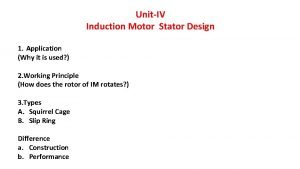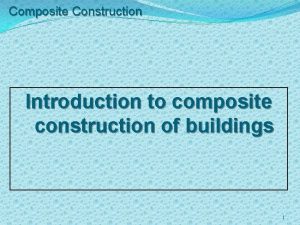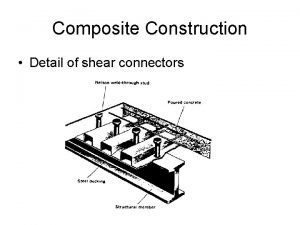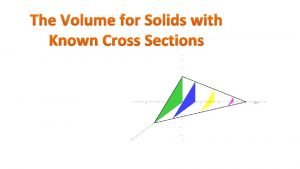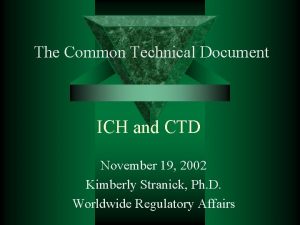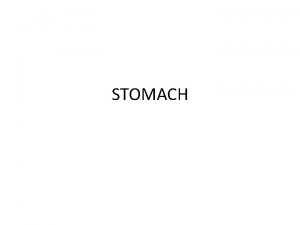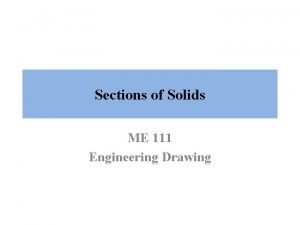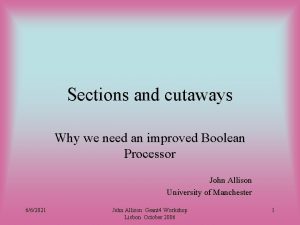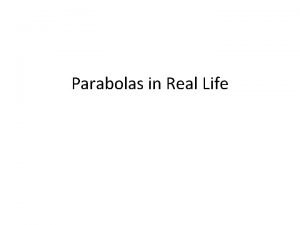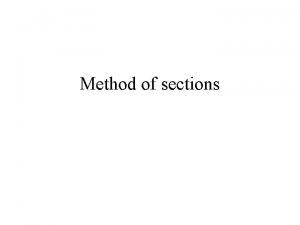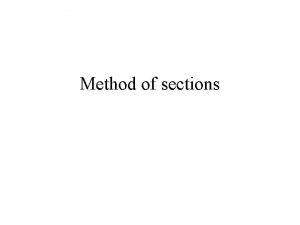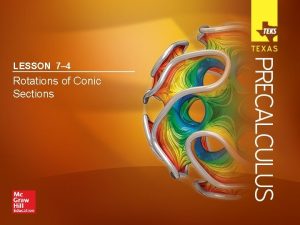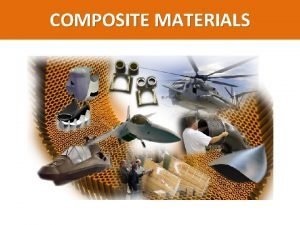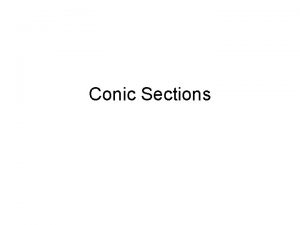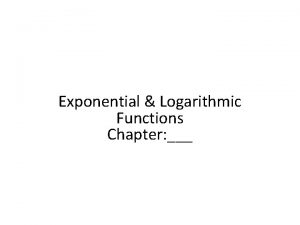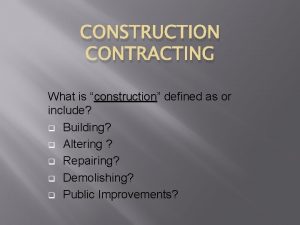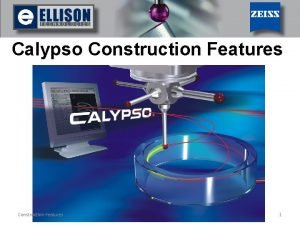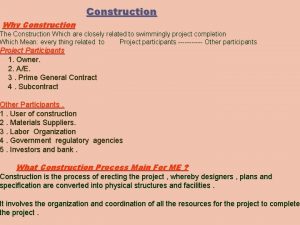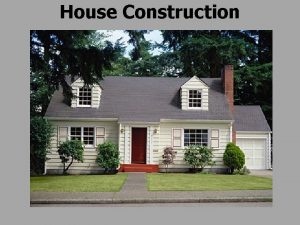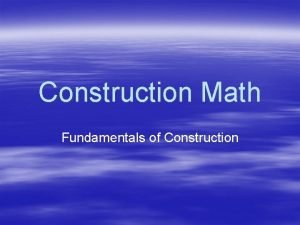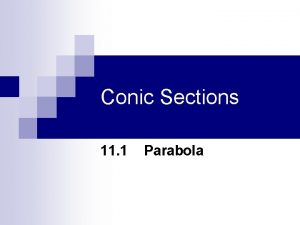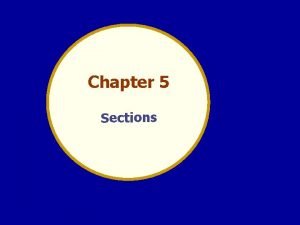UNITIV COMPOSITE CONSTRUCTION Composite Sections A composite section





















- Slides: 21

UNIT-IV COMPOSITE CONSTRUCTION

Composite Sections • A composite section in context of prestressed concrete members refers to a section with a precast member and castin-place (CIP) concrete. There can be several types of innovative composite sections. • The advantages of composite construction are as follows. – Savings in form work – Fast-track construction – Easy to connect the members and achieve continuity.

• The precast member can be first pretensioned or post-tensioned at the casting site. • After the cast-in-place (cast-in-situ) concrete achieves strength, the section is further posttensioned. • The grades of concrete for the precast member and the cast-in-place portion may be different. • In such a case, a transformed section is used to analyse the composite section.

Analysis for stresses • The analysis of a composite section depends upon the type of composite section, the stages of prestressing, the type of construction and the loads. • The type of construction refers to whether the precast member is propped or unpropped during the casting of the CIP portion. • If the precast member is supported by props along its length during the casting, it is considered to be propped. • Else, if the precast member is supported only at the ends during the casting, it is considered to be unpropped.


• Stress profiles for the precast web • At service (after the section behaves like a composite section) the following are the stress profiles for the full depth of the composite section.

Estimation of Deflection • Deflections are computed by taking into account the different stages of loading as well as the differences in the modulus of elasticity of concrete in the prestressed unit and the in situ cast elements. • The initial deflection due to prestress, self-weight of the beam and the weight of in situ cast concrete. • If the beam is not propped is computed on the basis of the section and modulus of elasticity of the precast unit. • If the precast beam is propped during constructions, the deflection due to the dead weight of in situ concrete is also computed on the basis of the composite sections

Flexural strength of composite members • The ultimate strength of composite prestressed sections in flexure is governed by the same principles used for ordinary prestressed concrete. • The percentage of tensioned reinforcement is less than that in most simple beams, so that the section is invariably under-reinforced. • The compression zone generally contains entirely of in situ concrete of lower compressive strength and the value of the cube strength of concrete to be used in flexural strength equations will obviously be that of in situ cast concrete. • If the compressive zone contains a part of precast elements, the average compressive strength computed by considering the crosssectional areas of in situ and precast concrete is used in the computation of compressive forces.

Shear strength of composite members • The support sections of composite members where web shear cracks are likely to develop should be cracked under service loads for safety against cracking in shear. • The ultimate shear strength of composite sections with web-shear or flexural shear cracks is computed using the empirical expressions suggested in British, American and Indian standard codes. • If the shear at the section under design ultimate loads exceeds the shear strength, suitable shear reinforcements are designed according to design code provisions.

• Design ultimate horizontal shear stress at interface • When links are provided, their cross sectional area should be at least 0. 15 per cent of the contact area. The space of links in T-Beam ribs with composite flanges should exceed neither four times the minimum thickness of the in situ concrete nor 600 mm.

• The amount of steel required Ah is obtained from the equation • The ultimate limit state is computed by the expression

• The permissible value of the horizontal shear stress for different types of contact surfaces is specified as – 0. 6 N/mm 2, when ties are not provided and the contact surface of the precast elements is free of laitance and intentionally roughened to an amplitude of 5 mm. – 0. 6 N/mm 2, when minimum vertical ties, according to section 8. 3. 3 are provided and the contact surface is not roughened. – 2. 5 N/mm 2, when minimum vertical ties are provided and the contact surface is roughened to an amplitude of 5 mm.

• When shear stress exceeds 2. 5 N/mm 2 then shear friction reinforcement is to be designed and the required area of reinforcements is given by

Differential shrinkage • In composite members using prestressed units in situ cast concrete, a considerable proportion of the total shrinkage will have already taken place in the precast prestressed beam before the casting and hardening of the in situ concrete. • The magnitude of differential shrinkage is influenced by the composition of concrete and the environmental conditions to which the composite member is exposed. • A reasonable estimation of stresses developed due to differential shrinkage may be made using the following assumptions – The shrinkage is uniform over the in situ part of the section – Effect of creep and increase in modulus of elasticity with age and the component of shrinkage, which is common to both the units is negligible.

• The uniform tensile stress induced in the in situ concrete is εcs Ec and the magnitute of the tensile force is computed as Nsh = εcs Ec Ai Ai= Area of the in situ concrete section Ec= Modulus of elasticity of the in situ concrete

Stresses due to differential shrinkage

Shrinkage induced stresses • The maximum permissible stresses in the precast prestressed concrete and the in situ cast concrete are mainly governed by the compressive strength of concrete in the respective elements. • The higher value of compressive stress is permissible only in composite sections with the stipulation that the failure of the section is due to excessive elongation of steel. • This requirement is to safeguard against the explosive compressive failure of the concrete at the limit state of collapse.

• These stresses may be increased by up to 50 %, provided that the allowable tensile stress for the prestressed unit is reduced by the same amount. • The higher values of flexural tensile stresses are permitted since it has been proved by experiments that the development of cracking. • Which is prevented by the uncracked prestressed concrete which is bonded to the in situ concrete.

Design of composite sections • The dimensioning of composite sections involves determining the required size of the composite section using a standard precast prestressed beam of known section properties in order to support the required design service loads. • The critical stress condition generally occurs at the soffit of the precast prestressed element under minimum and maximum moments. • Hence, at the stage of transfer, when the minimum moment is acting on the precast prestressed beam, the stress condition is given by the expression.

• We then have the stress condition at the soffit of the composite section • The prestress required at the bottom and top fibres of the precast prestressed beam is computed under the following equations

Thank You
 Unitiv
Unitiv Composite construction definition
Composite construction definition Composite structure in building construction
Composite structure in building construction Shear connectors in composite construction
Shear connectors in composite construction Douglas fir elastic modulus
Douglas fir elastic modulus Solids of known cross sections
Solids of known cross sections Declaration of independence sections
Declaration of independence sections Declaration of independence sections
Declaration of independence sections Declaration of independence sections
Declaration of independence sections Ctd sections
Ctd sections Stomach
Stomach Solid
Solid What is true shape of section in engineering drawing
What is true shape of section in engineering drawing Cutaways and cross sections definition
Cutaways and cross sections definition Broken-out section
Broken-out section Pharynx
Pharynx Cobol sections
Cobol sections Pga sections map
Pga sections map Eiffel tower hyperbola
Eiffel tower hyperbola Method of section
Method of section Method of section
Method of section Rotating conic sections
Rotating conic sections
